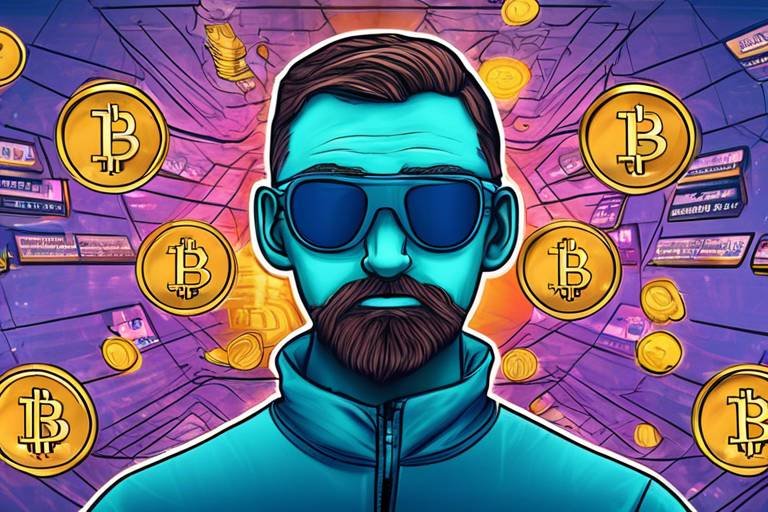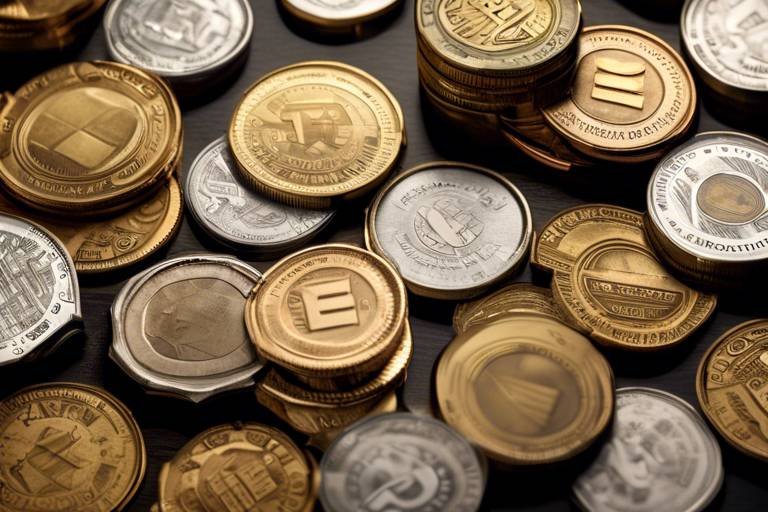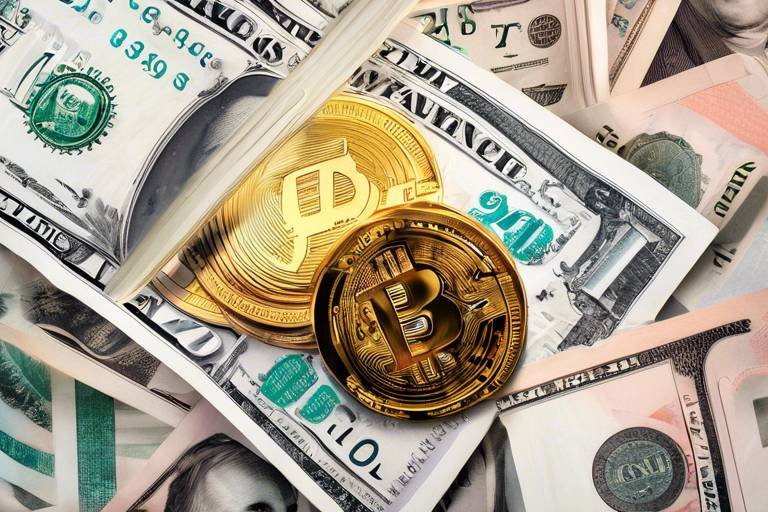The Future of Decentralized Finance and Market Dynamics
Decentralized finance, often referred to as DeFi, is revolutionizing the way we think about financial systems. Imagine a world where financial services are available to anyone with an internet connection, free from the constraints of traditional banking institutions. This transformation is not just a fleeting trend; it's a fundamental shift that is reshaping market dynamics across the globe. As we delve into the evolving landscape of DeFi, we'll uncover the innovations that are driving its growth and the implications these changes have for both consumers and financial markets.
At its core, DeFi represents a movement towards a more open and inclusive financial ecosystem. By leveraging blockchain technology, DeFi eliminates the need for intermediaries, allowing individuals to engage in peer-to-peer transactions seamlessly. This shift not only enhances accessibility but also fosters a sense of empowerment among users, enabling them to take control of their financial destinies. But what does this mean for the future of finance? Well, as DeFi continues to evolve, we can expect to see a range of exciting developments that will challenge traditional financial paradigms.
One of the most significant aspects of DeFi is its potential to democratize access to financial services. In a world where billions remain unbanked, the ability to participate in financial markets through decentralized platforms can be a game-changer. Users can lend, borrow, trade, and earn interest on their assets without the need for a bank account or credit history. This opens up a plethora of opportunities, particularly for those in developing regions where traditional banking infrastructure is lacking.
As we look ahead, the integration of DeFi with traditional finance is poised to create a hybrid financial landscape. Established financial institutions are beginning to recognize the potential of DeFi, experimenting with blockchain technology and exploring partnerships with decentralized platforms. This convergence could lead to enhanced efficiency, reduced costs, and improved customer experiences. However, it also raises questions about regulation and the need for a balanced approach that protects consumers while fostering innovation.
Moreover, the future of DeFi is heavily reliant on technological advancements. Innovations such as interoperability solutions will play a crucial role in connecting various blockchain networks, allowing users to navigate seamlessly between different platforms. This will not only enhance user experience but also expand market access, creating a more vibrant and interconnected financial ecosystem.
In conclusion, the future of decentralized finance is bright, filled with opportunities and challenges alike. As we embrace this new era, it is essential to stay informed about the developments shaping the DeFi landscape. By understanding the implications of these changes, we can better navigate the evolving market dynamics and harness the potential of decentralized finance to create a more equitable financial future for all.
- What is Decentralized Finance (DeFi)?
DeFi refers to financial services that operate on blockchain technology, enabling peer-to-peer transactions without intermediaries. - How does DeFi differ from traditional finance?
DeFi eliminates the need for banks and other intermediaries, allowing users to have direct control over their financial transactions. - What are the risks associated with DeFi?
Risks include security vulnerabilities, regulatory challenges, and the potential for market volatility. - Why is interoperability important in DeFi?
Interoperability allows different blockchain networks to communicate, enhancing user experience and expanding market access. - How are traditional financial institutions adapting to DeFi?
Many are exploring partnerships with DeFi platforms and leveraging blockchain technology to improve their services.
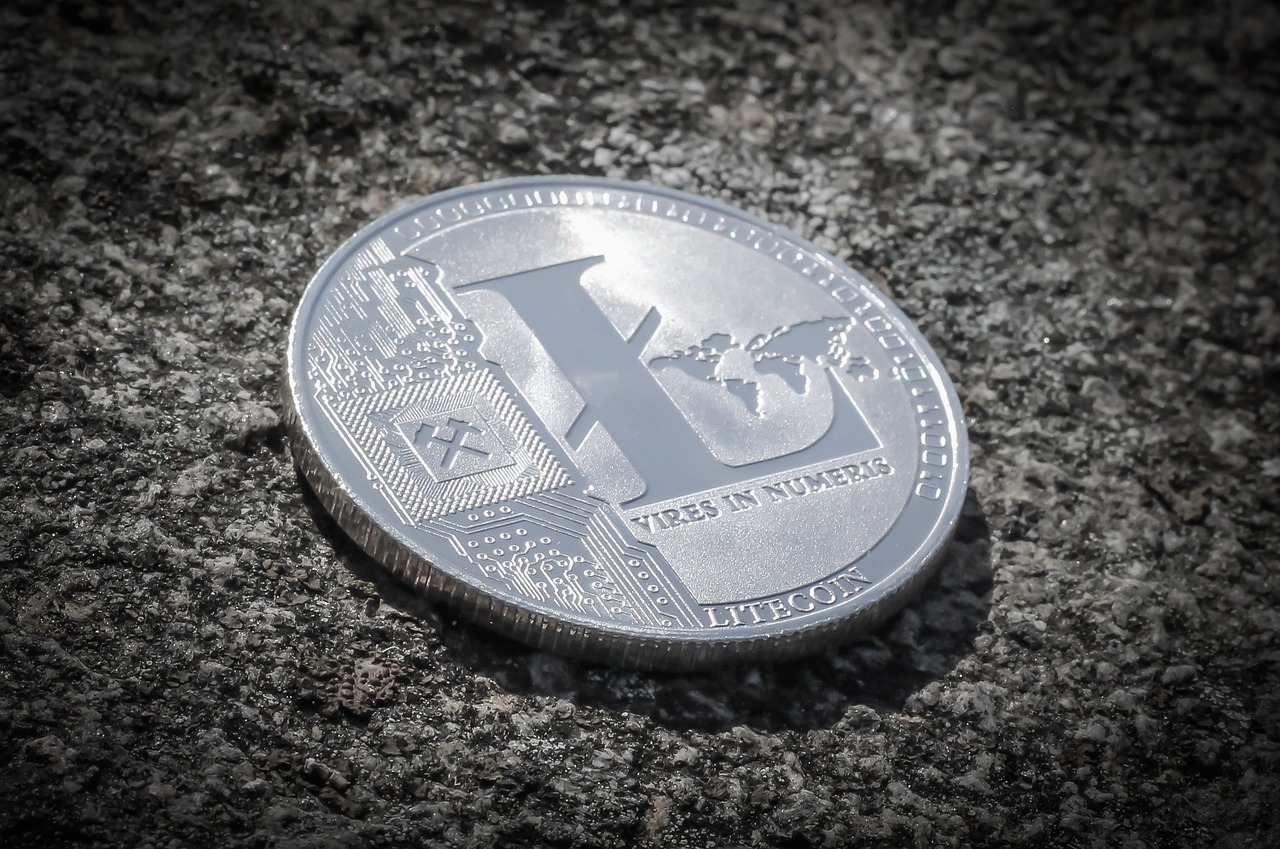
Understanding Decentralized Finance
Decentralized finance, commonly referred to as DeFi, is revolutionizing the financial landscape by leveraging blockchain technology to create a more open and accessible financial system. Imagine a world where you can lend, borrow, and trade without the need for traditional banks or financial institutions. That's the essence of DeFi! By eliminating intermediaries, DeFi not only reduces costs but also enhances the speed and efficiency of transactions.
At its core, DeFi operates on the principle of peer-to-peer transactions. This means that individuals can interact directly with one another, conducting financial activities without the oversight of a central authority. This opens up a plethora of opportunities for users across the globe, particularly those who are underserved by traditional banking systems. In fact, the DeFi movement is often seen as a response to the limitations and inefficiencies of conventional finance, which can be slow, costly, and exclusionary.
The benefits of DeFi are numerous and impactful. Here are some key advantages:
- Transparency: All transactions are recorded on a public blockchain, allowing anyone to verify and audit them.
- Accessibility: Anyone with an internet connection can access DeFi services, making it easier for people in remote areas to participate in the financial system.
- Control: Users have full control over their assets, eliminating the risk of bank failures or restrictions on withdrawals.
- Innovation: DeFi encourages the development of new financial products and services that cater to diverse needs.
However, understanding DeFi goes beyond just its advantages. It's essential to grasp the underlying technologies that make it possible. Blockchain technology serves as the foundation, providing a secure and immutable ledger for transactions. This enhances trust and transparency, two critical elements in financial dealings. Moreover, the use of smart contracts automates processes and ensures that agreements are executed as intended without the need for intermediaries.
In summary, DeFi represents a significant shift in how we think about finance. It empowers individuals, fosters innovation, and creates a more inclusive financial ecosystem. As we continue to explore this exciting landscape, it’s crucial to remain informed about the technologies and principles driving this transformation.

Key Technologies Driving DeFi
Decentralized Finance, or DeFi, is revolutionizing the financial landscape, and at the heart of this transformation are several key technologies that make it all possible. Understanding these technologies is crucial for anyone looking to navigate the DeFi space effectively. The trio of blockchain technology, smart contracts, and decentralized applications (dApps) form the foundational pillars of DeFi, each playing a unique role in enabling a more accessible and efficient financial system.
First and foremost, blockchain technology serves as the backbone of DeFi, providing a secure and immutable ledger for all transactions. Imagine a digital ledger that is not only transparent but also resistant to tampering—this is what blockchain offers. Each transaction is recorded in a block and linked to the previous one, creating a chain that is nearly impossible to alter. This technology enhances trust among users, as they can verify transactions independently without relying on a central authority.
The significance of blockchain cannot be overstated. It ensures that all transactions are secure, traceable, and irreversible. With its decentralized nature, blockchain eliminates the need for intermediaries, reducing costs and increasing efficiency. For instance, in traditional finance, transferring money across borders can involve hefty fees and long wait times. In contrast, blockchain enables peer-to-peer transactions that can be completed in a matter of minutes, often at a fraction of the cost.
Next up, we have smart contracts. These self-executing contracts, with the terms of the agreement directly written into code, automate and enforce transactions without the need for intermediaries. Think of them as digital vending machines: you make a selection, insert your payment, and the machine delivers your item without any human intervention. In the DeFi world, smart contracts facilitate everything from simple token swaps to complex financial agreements, ensuring that all parties adhere to the terms without the risk of manipulation.
However, while smart contracts offer numerous benefits, they are not without risks. Bugs in the code or vulnerabilities can lead to significant financial losses, as once deployed, they cannot be easily altered. Therefore, rigorous testing and auditing are essential to ensure their security and reliability.
Finally, we have decentralized applications (dApps), which provide user-friendly interfaces for accessing DeFi services. These applications allow users to interact with the blockchain and utilize smart contracts without needing to understand the underlying technology. Imagine dApps as the storefronts of a bustling marketplace, where each shop offers different services, from lending and borrowing to trading and investing.
dApps are crucial for expanding access to financial services, particularly for those who may not have access to traditional banking systems. They empower users by providing a seamless experience that caters to their needs while maintaining the core principles of decentralization and transparency.
| Technology | Description | Benefits |
|---|---|---|
| Blockchain | Decentralized ledger that records all transactions. | Security, transparency, lower costs. |
| Smart Contracts | Self-executing contracts with terms coded into the blockchain. | Automation, efficiency, reduced need for intermediaries. |
| dApps | Applications that run on a decentralized network. | User-friendly access to DeFi services, enhanced accessibility. |
In summary, the synergy between blockchain technology, smart contracts, and dApps is what drives the DeFi revolution. Each technology contributes to a more efficient, transparent, and accessible financial system. As these technologies continue to evolve, they will undoubtedly shape the future of finance in ways we can only begin to imagine.
- What is DeFi? Decentralized Finance (DeFi) refers to financial services that operate on blockchain technology, allowing for peer-to-peer transactions without intermediaries.
- How does blockchain enhance security? Blockchain provides a secure and immutable ledger for transactions, reducing the risk of fraud and increasing trust among users.
- What are smart contracts? Smart contracts are self-executing contracts with the terms of the agreement directly written into code, allowing for automated transactions.
- What role do dApps play in DeFi? dApps provide user-friendly interfaces for accessing DeFi services, enabling users to interact with blockchain technology without needing technical knowledge.

Blockchain Technology
Blockchain technology serves as the backbone of decentralized finance (DeFi), revolutionizing how we perceive and conduct financial transactions. Imagine a digital ledger that is not only secure but also transparent and accessible to everyone. That's what blockchain offers! By allowing data to be stored across a network of computers, it eliminates the need for a central authority, which is a game-changer for trust in financial dealings. With blockchain, every transaction is recorded and immutable, meaning once it's added to the chain, it cannot be altered or deleted. This ensures that all parties involved can verify the authenticity of transactions without relying on intermediaries.
One of the most compelling aspects of blockchain technology is its transparency. Every participant in the network can view the entire transaction history, which significantly reduces the chances of fraud. This is akin to having a public library where everyone can check out the same book, ensuring that no one can sneak in and change the pages without anyone noticing. Furthermore, because blockchain operates on a decentralized model, it is inherently resistant to censorship and manipulation, making it an appealing option for those who value privacy and autonomy in their financial activities.
Moreover, blockchain technology enhances security through cryptographic techniques. Each block in the chain is linked to the previous one, forming a secure chain that is extremely difficult to break. This is similar to a chain of locks; if one lock is strong, the whole chain remains secure. Additionally, the use of consensus mechanisms, such as Proof of Work or Proof of Stake, ensures that all transactions are verified by multiple participants in the network before being added to the blockchain. This collective validation process not only enhances security but also builds trust among users.
As the DeFi ecosystem continues to grow, the importance of blockchain technology cannot be overstated. It is the foundation upon which the future of finance will be built. For instance, many DeFi platforms leverage blockchain to offer services such as lending, borrowing, and trading without the need for traditional banks. This democratization of finance allows individuals from all walks of life to access financial services that were previously out of reach. The potential for financial inclusion is immense, as blockchain technology enables anyone with an internet connection to participate in the global economy.
In summary, blockchain technology is not just a trend; it is a fundamental shift in how we manage and exchange value. Its decentralized nature, transparency, security, and ability to facilitate trustless transactions make it an essential component of the DeFi landscape. As we look to the future, the ongoing innovations in blockchain technology will likely lead to even more exciting developments, paving the way for a more inclusive and efficient financial system.
- What is blockchain technology?
Blockchain technology is a decentralized digital ledger that records transactions across multiple computers in a way that the registered transactions cannot be altered retroactively. - How does blockchain ensure security?
Blockchain uses cryptographic techniques and consensus mechanisms to secure transactions, ensuring that they are verified by multiple participants before being added to the chain. - What are the benefits of using blockchain in finance?
Blockchain offers transparency, security, and the elimination of intermediaries, which can lead to lower costs and faster transactions. - Can blockchain be hacked?
While the blockchain itself is highly secure, vulnerabilities can exist in the applications built on top of it. However, the decentralized nature of blockchain makes it extremely difficult to alter past transactions.

Smart Contracts Explained
Smart contracts are a revolutionary concept that has transformed the way we think about agreements and transactions in the world of decentralized finance (DeFi). At their core, smart contracts are self-executing contracts with the terms of the agreement directly written into code. This means that once the conditions are met, the contract automatically executes without the need for a middleman. Imagine a vending machine: you put in your money and select your item, and the machine automatically delivers it to you. Smart contracts operate on a similar principle, ensuring that all parties fulfill their obligations without requiring trust or oversight from a third party.
One of the most significant benefits of smart contracts is their ability to enhance transparency and security. Since they are built on blockchain technology, every transaction is recorded on a public ledger, making it nearly impossible to alter or tamper with the contract once it is deployed. This feature not only builds trust among users but also reduces the likelihood of fraud. Furthermore, smart contracts can significantly lower transaction costs by eliminating intermediaries, which can be a game-changer for many businesses and individuals.
However, while the benefits are substantial, there are also potential risks associated with smart contracts. Coding errors or vulnerabilities can lead to unintended consequences, such as loss of funds or exploitation by malicious actors. For instance, if a smart contract has a flaw, it could be manipulated, resulting in financial losses for users. Therefore, it's crucial for developers to conduct thorough audits and testing before deploying smart contracts to minimize these risks.
In summary, smart contracts are a powerful tool in the DeFi ecosystem, offering a myriad of advantages including:
- Automation: They execute automatically when conditions are met, reducing the need for manual intervention.
- Cost Efficiency: By cutting out intermediaries, they lower transaction fees.
- Transparency: All transactions are recorded on the blockchain, ensuring visibility and trust.
- Security: Their decentralized nature makes them resistant to tampering.
As the DeFi landscape continues to evolve, smart contracts will undoubtedly play a pivotal role in shaping the future of finance. Their ability to streamline processes and enhance security makes them an essential component of the decentralized economy. However, as with any technology, understanding their intricacies and potential pitfalls is critical for anyone looking to engage with DeFi.
- What is a smart contract? A smart contract is a self-executing contract where the terms are directly written into code, allowing for automated execution once conditions are met.
- How do smart contracts enhance security? They operate on blockchain technology, making them immutable and transparent, which reduces the risk of fraud.
- What are the risks associated with smart contracts? Potential risks include coding errors and vulnerabilities that can be exploited, leading to financial losses.
- Can smart contracts be modified after deployment? No, once a smart contract is deployed on the blockchain, it cannot be changed or tampered with.
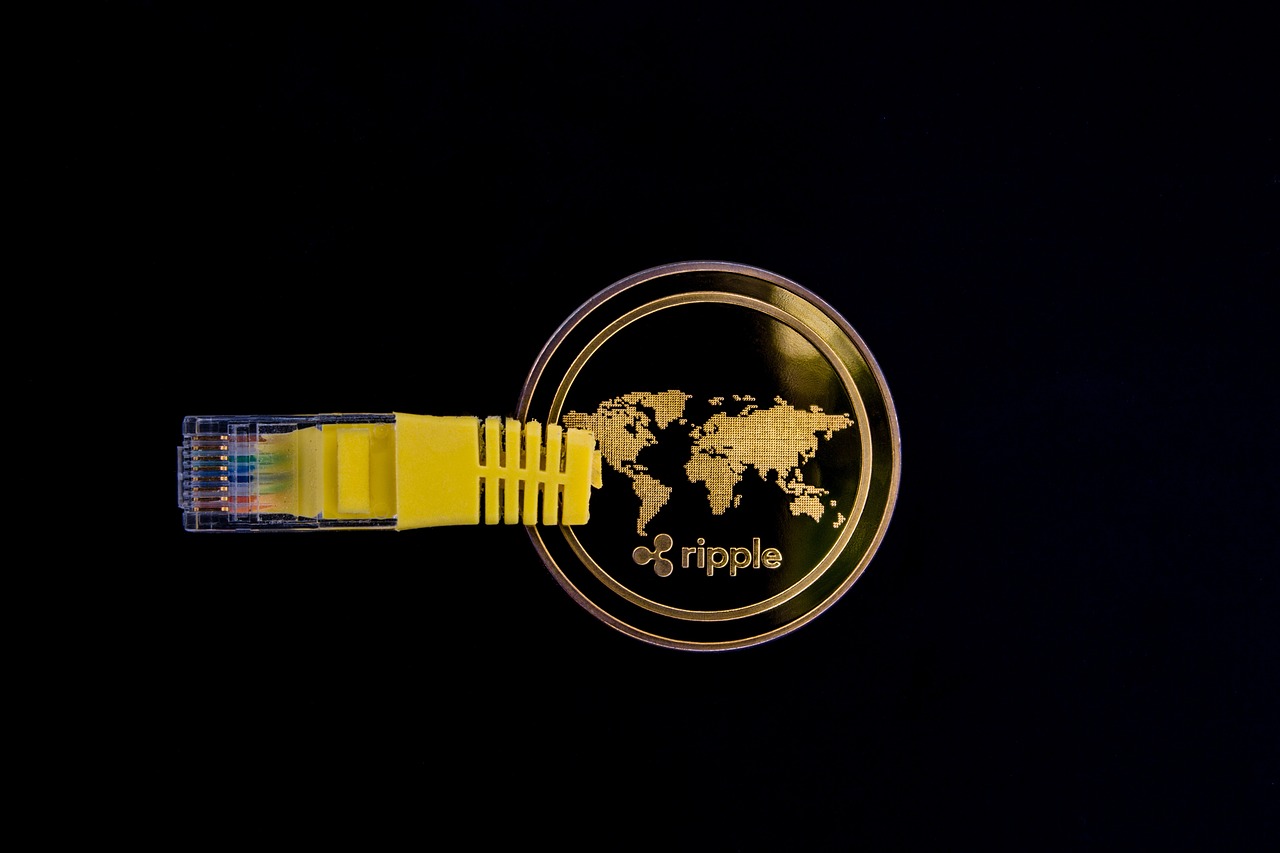
Decentralized Applications (dApps)
Decentralized Applications, commonly known as dApps, represent a groundbreaking shift in how we engage with technology and finance. Unlike traditional applications that rely on centralized servers and authorities, dApps operate on a blockchain, enabling users to interact directly with each other. This peer-to-peer model not only enhances transparency but also significantly reduces the risk of censorship and fraud. Imagine a world where you can send money to a friend without needing a bank or a payment processor—this is the reality that dApps are creating.
One of the most exciting aspects of dApps is their user-friendly interfaces. Developers are working tirelessly to ensure that these applications are not only powerful but also accessible to everyone, even those who may not be tech-savvy. For instance, many dApps come with intuitive designs that allow users to navigate complex processes with ease. This democratization of technology is crucial for the widespread adoption of decentralized finance.
Moreover, dApps are built on various blockchain platforms, each offering unique features and benefits. The most popular platforms include:
- Ethereum: Known for its robust smart contract capabilities, Ethereum hosts a vast majority of dApps, especially in the DeFi sector.
- Binance Smart Chain: This platform is gaining traction due to its lower transaction fees and faster processing times, making it an attractive option for developers.
- Polkadot: With its focus on interoperability, Polkadot allows different blockchains to communicate, paving the way for innovative dApp solutions.
As the ecosystem evolves, the potential for dApps to disrupt various industries is enormous. From finance and gaming to supply chain management and healthcare, the applications are virtually limitless. For example, dApps can facilitate transparent voting systems, allowing communities to make collective decisions without the risk of manipulation. Similarly, in the gaming industry, dApps enable players to truly own their in-game assets through blockchain technology, creating a new economy of digital ownership.
However, it's essential to acknowledge that the journey of dApps is not without challenges. Issues such as scalability, security, and user adoption continue to pose hurdles. Developers are actively working on solutions, such as layer-2 scaling solutions which aim to enhance transaction speeds and reduce costs. As these challenges are addressed, we can expect dApps to become more prevalent in our daily lives.
In summary, dApps are at the forefront of the decentralized finance revolution, offering innovative solutions that empower users and redefine traditional financial paradigms. As we continue to explore their potential, it’s clear that the future of finance is not just decentralized but also more inclusive and accessible than ever before.
- What is a dApp? A dApp is a decentralized application that runs on a blockchain network, allowing for peer-to-peer interactions without a central authority.
- How do dApps work? dApps utilize smart contracts on a blockchain to automate processes and facilitate transactions directly between users.
- Are dApps secure? While dApps can offer enhanced security through decentralization, they are not immune to vulnerabilities. Users should always conduct due diligence.
- Can I create my own dApp? Yes! With the right knowledge of blockchain technology and programming, anyone can develop their own dApp.

Risks and Challenges in DeFi
While decentralized finance (DeFi) presents a revolutionary approach to financial services, it is not without its risks and challenges. As with any emerging technology, the rapid growth of DeFi has opened the door to various vulnerabilities that users and developers must navigate. Understanding these risks is crucial for anyone looking to engage with DeFi platforms.
One of the most pressing concerns is security vulnerabilities. DeFi platforms are often built on complex smart contracts that, while designed to be self-executing and tamper-proof, can still contain bugs or loopholes. These flaws can lead to significant financial losses, as seen in several high-profile hacks where millions of dollars were siphoned off due to poorly coded contracts. For instance, the infamous DAO hack in 2016 resulted in the theft of over $60 million worth of Ether, showcasing the potential pitfalls of smart contract reliance.
Another challenge is the issue of regulatory uncertainty. As DeFi continues to gain traction, regulators worldwide are grappling with how to classify and govern these platforms. The lack of clear regulations can create a risky environment for investors, as they may find themselves unprotected in the event of fraud or system failures. This uncertainty can also deter traditional financial institutions from fully embracing DeFi, limiting its growth potential.
Moreover, the liquidity risks inherent in DeFi protocols can pose significant challenges. Many DeFi platforms rely on liquidity pools, where users provide funds in exchange for rewards. However, if liquidity dries up—either due to market fluctuations or user withdrawals—the platform may struggle to operate effectively, leading to slippage and increased costs for users. This situation can create a vicious cycle that undermines trust in DeFi services.
In addition, the user experience in DeFi can be daunting for newcomers. The technical jargon and complex interfaces can alienate potential users, making it difficult for them to navigate the ecosystem. This steep learning curve can hinder widespread adoption, as many individuals may feel overwhelmed or intimidated by the technology. Addressing this challenge is essential for fostering a more inclusive DeFi environment.
Finally, scalability issues pose another significant hurdle. As more users flock to DeFi platforms, the underlying blockchain networks can become congested, leading to slower transaction times and higher fees. This can frustrate users and deter them from utilizing DeFi services, ultimately stunting the growth of the entire sector.
In conclusion, while the potential of DeFi is immense, it is crucial for users and developers alike to remain vigilant about the associated risks. By understanding these challenges, stakeholders can better prepare for the future and work towards creating a more secure and user-friendly DeFi landscape.
- What are the main risks associated with DeFi? The main risks include security vulnerabilities in smart contracts, regulatory uncertainty, liquidity risks, user experience challenges, and scalability issues.
- How can I protect myself when using DeFi platforms? To protect yourself, always conduct thorough research, use reputable platforms, and consider diversifying your investments to mitigate risks.
- Are there regulations for DeFi? Currently, the regulatory landscape for DeFi is evolving, with many jurisdictions still determining how to classify and govern these platforms.
- What can be done to improve user experience in DeFi? Simplifying interfaces, providing educational resources, and enhancing customer support can significantly improve the user experience in DeFi.

The Role of Governance in DeFi
When we think about the future of decentralized finance (DeFi), one crucial element stands out: governance. Unlike traditional finance, where decision-making often lies in the hands of a few executives or board members, DeFi operates on a different paradigm. Here, the power is distributed among the community, allowing users to have a say in how projects evolve. This community-driven approach not only fosters a sense of ownership but also enhances transparency and accountability.
At the heart of DeFi governance are Decentralized Autonomous Organizations (DAOs). DAOs are essentially organizations that are run by smart contracts, allowing members to participate in decision-making processes through voting mechanisms. This innovative structure empowers users to influence project directions, whether it's approving new features, allocating funds, or making changes to protocols. Imagine a company where every employee has a vote on the direction and strategy—this is what DAOs aim to achieve in the DeFi space.
However, governance in DeFi is not without its challenges. The diversity of opinions within a community can lead to disagreements and even conflicts. Additionally, the technical knowledge required to participate effectively can be a barrier for some users. As a result, while many users are eager to engage, they may feel overwhelmed by the complexity of governance mechanisms. This highlights the need for educational resources and user-friendly interfaces that can demystify the governance process.
Moreover, the evolution of governance models in DeFi is closely tied to the broader regulatory landscape. As traditional financial institutions and regulators begin to take notice of DeFi, there is a growing conversation about how governance should be structured to ensure compliance while still maintaining the core principles of decentralization. Balancing these interests is crucial for the long-term sustainability of DeFi projects.
To sum it up, governance in DeFi is a double-edged sword. It offers a unique opportunity for community involvement and innovation, but it also presents challenges that need to be addressed. As the DeFi space continues to grow, the importance of effective governance will only become more pronounced. The way communities navigate these challenges will ultimately shape the future of decentralized finance.
- What is the purpose of governance in DeFi? Governance in DeFi allows community members to participate in decision-making processes, ensuring that the project aligns with the interests of its users.
- How do DAOs function? DAOs operate through smart contracts, enabling members to vote on various proposals and changes within the organization.
- What challenges does DeFi governance face? Challenges include the complexity of governance mechanisms, potential conflicts within the community, and the need for regulatory compliance.
- Why is community involvement important? Community involvement fosters a sense of ownership and accountability, which can lead to more sustainable and user-centric projects.

Decentralized Autonomous Organizations (DAOs)
Decentralized Autonomous Organizations, or DAOs, are revolutionizing the way we think about governance in the financial sector. Imagine a world where decisions are made collectively, without the need for a central authority. Sounds futuristic, right? Well, that's exactly what DAOs offer. They are built on blockchain technology, allowing members to propose and vote on changes, ensuring that everyone has a voice in the direction of the organization. This democratic approach not only enhances transparency but also fosters a sense of community among participants.
At their core, DAOs operate through smart contracts, which automatically execute decisions based on the outcomes of member votes. This means that once a proposal is approved, the system takes care of the rest, eliminating the need for intermediaries. The beauty of this setup lies in its trustless nature; members can participate without needing to trust a single entity, as the rules are encoded in the blockchain. However, while DAOs empower users, they also come with their own set of challenges.
For instance, the decision-making process can sometimes be slow and cumbersome, especially if a large number of members are involved. Additionally, the risk of voting manipulation exists, where individuals with significant financial resources could sway votes in their favor. Despite these challenges, the potential for DAOs to reshape governance in DeFi is immense. They not only democratize decision-making but also pave the way for innovative funding models, such as community-driven projects and initiatives.
To illustrate the functionality of DAOs, consider the following table that highlights their key features:
| Feature | Description |
|---|---|
| Decentralization | Power is distributed among all members, reducing the risk of corruption. |
| Transparency | All transactions and decisions are recorded on the blockchain, accessible to everyone. |
| Autonomy | Smart contracts automate processes, minimizing human intervention. |
| Community-Driven | Members have the ability to propose and vote on initiatives. |
In conclusion, DAOs represent a significant shift in how organizations can operate, especially in the realm of finance. They empower users, promote transparency, and foster a collaborative environment. As we continue to explore the potential of decentralized finance, it's clear that DAOs will play a crucial role in shaping the future of governance in this space.
- What is a DAO? A DAO is a decentralized organization that operates through smart contracts on a blockchain, allowing members to participate in governance and decision-making.
- How do DAOs make decisions? DAOs make decisions through a voting process where members can propose changes and vote on them, with outcomes executed automatically by smart contracts.
- What are the benefits of DAOs? DAOs offer decentralization, transparency, and community-driven governance, allowing for a more democratic approach to organizational management.
- What challenges do DAOs face? DAOs may face slow decision-making processes and the risk of voting manipulation, especially when large stakeholders are involved.
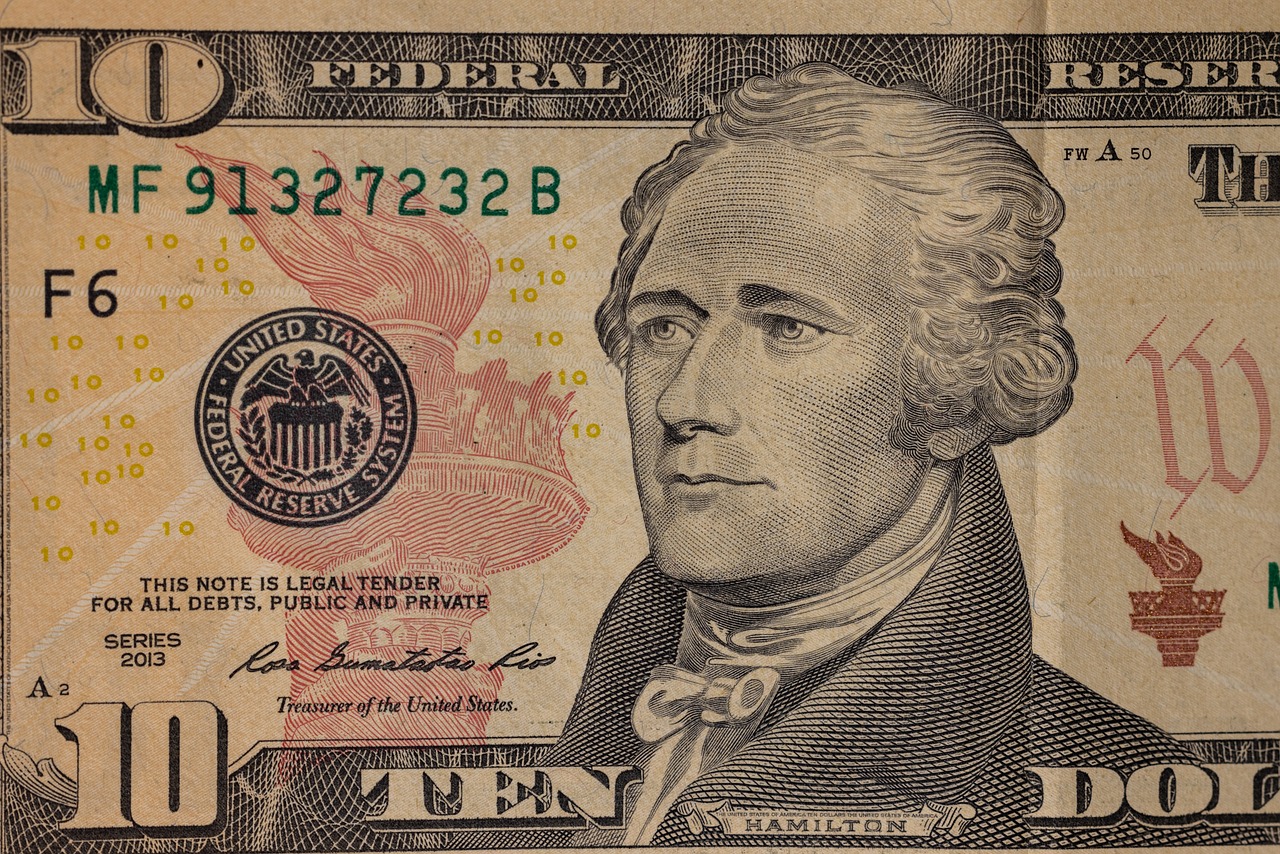
Regulatory Considerations
As the decentralized finance (DeFi) landscape continues to evolve, it faces an increasingly complex regulatory environment. Governments and regulatory bodies around the world are beginning to take notice of DeFi's rapid growth and the potential risks it poses to traditional financial systems. This scrutiny is not just a passing phase; it reflects a growing concern over consumer protection, market integrity, and the need for compliance with existing financial laws.
One of the primary challenges in regulating DeFi is its inherently decentralized nature. Unlike traditional financial institutions, which have clear points of accountability, DeFi operates on a peer-to-peer basis, often without a central authority. This makes it difficult for regulators to enforce compliance and monitor activities effectively. For example, if a user experiences a loss due to a smart contract vulnerability, determining liability can be a complicated process. Who is responsible? The developers? The users? Or is it just the nature of a decentralized system?
Moreover, the lack of regulatory clarity can stifle innovation. Developers and entrepreneurs in the DeFi space often find themselves navigating a murky landscape of rules that vary widely from one jurisdiction to another. In some regions, DeFi projects may be classified as securities, while in others, they may not be regulated at all. This inconsistency can lead to a chilling effect on new projects, as entrepreneurs may be hesitant to invest time and resources into initiatives that could be deemed illegal or non-compliant.
To address these issues, some jurisdictions are beginning to develop frameworks specifically tailored to DeFi. For instance, countries like Switzerland and Singapore are at the forefront of creating regulatory environments that encourage innovation while ensuring consumer protection. These frameworks often emphasize transparency, requiring DeFi projects to disclose their operational practices and risks to users. This approach not only helps build trust but also aligns DeFi with the broader goals of regulatory compliance.
| Country | Regulatory Approach |
|---|---|
| Switzerland | Developing a comprehensive framework for blockchain and DeFi projects. |
| Singapore | Implementing clear guidelines for token offerings and DeFi operations. |
| United States | Fragmented regulations with ongoing debates about classification and oversight. |
In addition to these country-specific approaches, there is a growing consensus among regulators about the need for international cooperation. Given the global nature of DeFi, a coordinated effort to establish common standards could help mitigate risks and promote a more stable financial ecosystem. This could involve collaboration between regulatory bodies, industry stakeholders, and even users to create a balanced approach that fosters innovation while protecting consumers.
In conclusion, the regulatory considerations surrounding DeFi are both complex and crucial for its future. As the landscape continues to change, it will be essential for stakeholders to engage in open dialogue with regulators to shape a framework that supports growth while safeguarding the interests of users. The balance between innovation and regulation will be pivotal in determining how DeFi integrates into the broader financial system.
- What are the main regulatory challenges facing DeFi? The primary challenges include the decentralized nature of DeFi, lack of regulatory clarity, and varying rules across jurisdictions.
- How are different countries approaching DeFi regulation? Some countries, like Switzerland and Singapore, are developing tailored frameworks, while others, like the United States, have a more fragmented approach.
- Why is international cooperation important for DeFi regulation? Given the global nature of DeFi, coordinated efforts can help mitigate risks and promote a stable financial ecosystem.
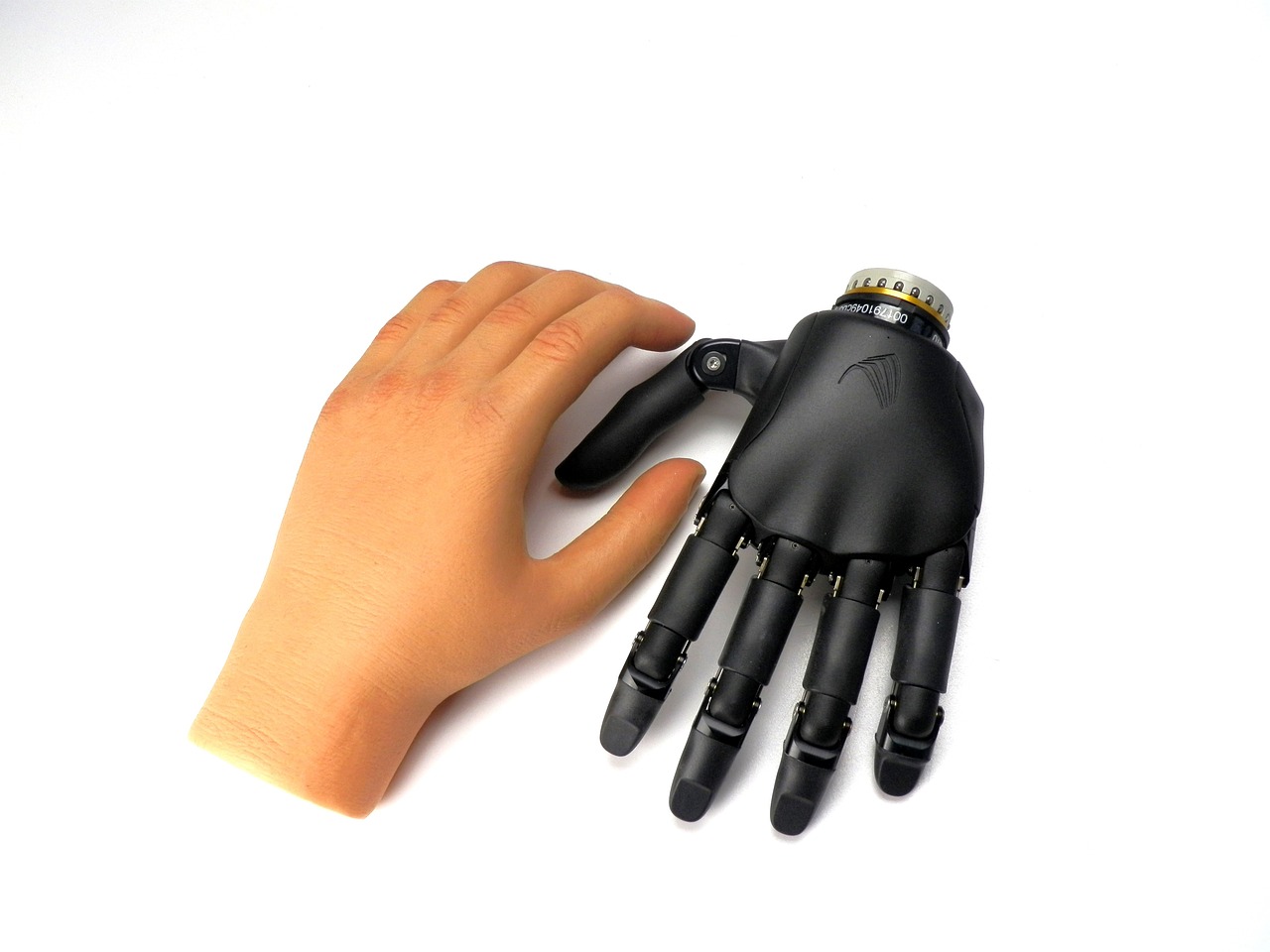
Future Trends in DeFi
The world of decentralized finance (DeFi) is evolving at a breathtaking pace, and the future promises even more exciting developments. As we look ahead, several key trends are emerging that could redefine the financial landscape. First and foremost, interoperability between various blockchain networks is becoming increasingly vital. Imagine a world where users can seamlessly move assets across different platforms without the hassle of conversions or delays. This kind of fluidity not only enhances user experience but also expands market access, allowing more participants to engage in DeFi activities.
Moreover, we are witnessing a significant shift towards the integration of DeFi with traditional finance. Major financial institutions are beginning to recognize the potential of blockchain technology and are exploring ways to incorporate DeFi solutions into their existing frameworks. This convergence could lead to a hybrid financial system where the best of both worlds—traditional security and decentralized innovation—coexist. For instance, banks might offer DeFi products, such as yield farming opportunities, to their customers, thereby expanding their service offerings while also tapping into the growing popularity of DeFi.
Another trend that cannot be overlooked is the rise of layer 2 solutions. These technologies aim to enhance the scalability of existing blockchain networks, allowing for faster and cheaper transactions. As DeFi applications become more popular, the demand for efficient and cost-effective solutions will grow. Layer 2 solutions, such as rollups, can help alleviate congestion on main networks, ensuring that users enjoy a smooth experience without the frustration of high fees and slow transaction times.
In addition to scalability, the concept of composability is gaining traction. Composability refers to the ability of different DeFi protocols to work together seamlessly. This interconnectedness allows developers to build complex financial products by stacking various DeFi services on top of one another, much like building blocks. The more composable the ecosystem becomes, the more innovative products can emerge, leading to a vibrant marketplace where users can access a wide array of financial tools.
Furthermore, the focus on user experience (UX) is becoming more pronounced. As DeFi continues to attract mainstream users, the need for intuitive and user-friendly interfaces is critical. Developers are now prioritizing design and functionality to ensure that even those unfamiliar with blockchain technology can easily navigate DeFi platforms. This shift towards better UX will play a crucial role in driving adoption, making it essential for projects to invest in creating engaging and accessible experiences.
Lastly, we cannot ignore the evolving landscape of governance in DeFi. As projects grow, the importance of decentralized governance models becomes increasingly clear. The rise of Decentralized Autonomous Organizations (DAOs) is a testament to this trend. DAOs empower users to participate in decision-making processes, giving them a voice in the direction of the project. This democratization of governance not only fosters a sense of community but also enhances accountability and transparency within DeFi ecosystems.
In conclusion, the future of DeFi is brimming with possibilities. With advancements in interoperability, integration with traditional finance, scalability through layer 2 solutions, composability, enhanced user experience, and decentralized governance, we are on the brink of a financial revolution. The question is, are you ready to embrace the changes that lie ahead?
- What is DeFi? DeFi stands for decentralized finance, which refers to financial services built on blockchain technology that operate without intermediaries.
- How does interoperability benefit DeFi? Interoperability allows users to move assets seamlessly across different blockchain networks, enhancing user experience and expanding market access.
- What role do DAOs play in DeFi? DAOs facilitate decentralized governance, empowering users to participate in decision-making processes and influence project developments.
- Why is user experience important in DeFi? A better user experience encourages adoption among mainstream users, making DeFi accessible to a wider audience.

Interoperability Solutions
In the rapidly evolving world of decentralized finance (DeFi), interoperability stands out as a crucial component for fostering seamless interactions between various blockchain networks. Imagine trying to communicate with someone who speaks a different language; without a common medium, the conversation becomes nearly impossible. This analogy perfectly illustrates the need for interoperability in DeFi. As more blockchain platforms emerge, the ability for these systems to work together becomes paramount for enhancing user experience and expanding market access.
Currently, many DeFi applications are built on isolated blockchains, which can limit their functionality and user reach. Interoperability solutions aim to bridge these gaps, allowing assets and data to flow freely across different networks. This not only increases liquidity but also opens up a wider array of services for users. For instance, a user could leverage the unique features of one blockchain while simultaneously utilizing the liquidity pools of another, creating a more dynamic and flexible financial environment.
There are several key technologies and protocols that facilitate interoperability in the DeFi space. One prominent example is the Wrapped Tokens. These tokens represent assets from one blockchain on another, enabling users to access various DeFi services without needing to leave their preferred platform. For example, Wrapped Bitcoin (WBTC) allows Bitcoin holders to participate in Ethereum-based DeFi applications, effectively merging the two ecosystems.
Another innovative solution is the use of cross-chain bridges, which enable the transfer of assets between different blockchain networks. These bridges act as conduits, allowing users to move their assets securely and efficiently. Imagine a bridge connecting two islands; without it, travel between the two would be cumbersome and time-consuming. Cross-chain bridges simplify this process, fostering a more interconnected DeFi landscape.
Moreover, projects like Polkadot and Cosmos are pioneering the concept of multi-chain architectures. These platforms are designed with interoperability at their core, allowing different blockchains to communicate and share information seamlessly. By leveraging these technologies, developers can create applications that tap into the strengths of multiple networks, ultimately enhancing the overall user experience.
However, while the promise of interoperability is exciting, it is essential to recognize the challenges that come with it. Security is a significant concern, as cross-chain transactions can create vulnerabilities that hackers might exploit. Additionally, the complexity of these systems can lead to user confusion, potentially hindering adoption. Therefore, as the DeFi space continues to grow, addressing these challenges will be critical for ensuring that interoperability solutions are both effective and secure.
In conclusion, interoperability solutions are not just a trend; they are a fundamental requirement for the future of DeFi. As the ecosystem matures, the integration of various blockchain networks will pave the way for a more inclusive financial landscape. This interconnectedness will empower users, enhance liquidity, and foster innovation, ultimately reshaping the way we think about finance in the digital age.
Frequently Asked Questions
- What is interoperability in DeFi? Interoperability in DeFi refers to the ability of different blockchain networks to communicate and work together, allowing for seamless asset transfers and data sharing.
- Why is interoperability important? It enhances user experience by enabling access to a wider range of services and liquidity, fostering a more dynamic and interconnected financial environment.
- What are some examples of interoperability solutions? Examples include wrapped tokens, cross-chain bridges, and multi-chain architectures like Polkadot and Cosmos.
- What challenges does interoperability face? Security vulnerabilities and complexity of systems can hinder the effectiveness of interoperability solutions.

Integration with Traditional Finance
The convergence of Decentralized Finance (DeFi) and traditional finance is not just a passing trend; it’s a transformative shift that could redefine how we think about money and transactions. Imagine a world where banks and blockchain coexist, working together rather than against each other. This integration is already underway, with traditional financial institutions beginning to recognize the immense potential of DeFi technologies.
One of the most compelling aspects of this integration is the ability for traditional banks to leverage blockchain technology to enhance their operations. Banks can utilize blockchain for various functions, such as improving transaction speeds, reducing costs, and increasing security. By adopting decentralized systems, they can streamline processes that have historically been bogged down by intermediaries and outdated technologies. For instance, cross-border payments that typically take days can be executed in mere minutes, thanks to blockchain.
Moreover, the integration of DeFi into traditional finance opens up new avenues for financial inclusion. Many individuals around the globe lack access to basic banking services, but with DeFi platforms, anyone with an internet connection can participate in the financial ecosystem. This democratization of finance is crucial, as it allows people to engage in lending, borrowing, and investing without needing a bank account. In fact, a recent report indicated that over 1.7 billion adults worldwide remain unbanked, highlighting the vast potential for DeFi to fill this gap.
However, the journey towards integration is not without its challenges. Traditional financial institutions are often bound by regulatory frameworks that can be at odds with the decentralized nature of DeFi. As a result, many banks are cautiously exploring partnerships with DeFi projects to navigate these complexities. For example, some banks are investing in blockchain startups or developing their own decentralized solutions to stay competitive in this rapidly evolving landscape.
To better understand this integration, consider the following key areas where traditional finance and DeFi intersect:
- Asset Tokenization: Traditional assets like real estate and stocks can be tokenized on the blockchain, providing liquidity and accessibility.
- Decentralized Exchanges (DEXs): These platforms allow users to trade cryptocurrencies without the need for a centralized authority, offering a glimpse into a future where trading could be entirely decentralized.
- Stablecoins: These are cryptocurrencies pegged to traditional currencies, providing a bridge between the volatility of crypto and the stability of fiat currencies.
As we look to the future, it is clear that the integration of DeFi with traditional finance is not merely a possibility; it is an inevitability. The financial landscape is evolving, and those who adapt to these changes will be the ones to thrive. Financial institutions that embrace DeFi technologies will not only enhance their service offerings but also position themselves as leaders in a new era of finance.
- What is DeFi?
Decentralized Finance (DeFi) refers to financial services that operate on blockchain technology, enabling peer-to-peer transactions without intermediaries.
- How does DeFi integrate with traditional finance?
DeFi integrates with traditional finance by leveraging blockchain technology for improved efficiency, security, and accessibility, often through partnerships and innovation.
- What are the risks associated with DeFi?
While DeFi offers many benefits, it also comes with risks such as security vulnerabilities, regulatory challenges, and market volatility.
- Will DeFi replace traditional finance?
It is unlikely that DeFi will completely replace traditional finance; instead, they will likely coexist and complement each other, creating a more robust financial ecosystem.
Frequently Asked Questions
-
What is decentralized finance (DeFi)?
Decentralized finance, or DeFi, refers to a new financial ecosystem built on blockchain technology that allows for peer-to-peer transactions without the need for intermediaries like banks. Imagine being able to lend, borrow, and trade assets directly with others, all while maintaining control over your funds. It's like having a financial system that operates on its own, free from traditional constraints!
-
How do smart contracts work in DeFi?
Smart contracts are self-executing contracts with the terms of the agreement directly written into code. They automatically enforce and execute transactions when conditions are met, eliminating the need for intermediaries. Think of them as digital vending machines: you put in the right amount of cryptocurrency, and you get the service or asset you want, all without any human involvement!
-
What are the risks associated with DeFi?
While DeFi offers exciting opportunities, it also comes with risks such as smart contract vulnerabilities, market volatility, and regulatory uncertainties. Just like walking a tightrope, the potential for high rewards exists, but so do significant risks that users must navigate carefully.
-
What role do Decentralized Autonomous Organizations (DAOs) play in DeFi?
DAOs are organizations represented by rules encoded as a computer program that is transparent and controlled by organization members. They enable community-driven decision-making in DeFi projects, allowing users to vote on proposals and influence the direction of the project. It's like having a community board where every member has a say in how things are run!
-
How is DeFi regulated?
The regulatory landscape for DeFi is still evolving, with governments and regulatory bodies around the world beginning to take a closer look at how these platforms operate. As DeFi continues to grow, it’s crucial for users to stay informed about the regulations that may affect their activities, much like keeping an eye on the weather before heading out for a hike!
-
What future trends can we expect in DeFi?
The future of DeFi is bright, with trends like interoperability between different blockchain networks and the integration of DeFi with traditional finance on the horizon. This means that we might soon see a world where your bank and DeFi platforms work together seamlessly, creating a more inclusive financial ecosystem!









